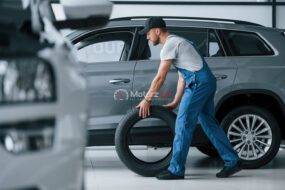The Evolution of Safety Features How Cars Are Getting Safer industry has come a long way since the invention of the motor vehicle. Over the years, cars have evolved not only in terms of design, performance, and comfort but also in safety features. The relentless pursuit of safety has been a driving force behind the automotive industry’s progress. In this article, we will explore the evolution of safety features in cars and how they have contributed to making our roads safer.
The Early Days: Minimal Safety Measures
When automobiles first hit the roads in the late 19th century, safety was not a top priority. Early cars lacked even the most basic safety features we take for granted today. There were no seatbelts, airbags, or reinforced structures to protect occupants in the event of a crash. Drivers and passengers were at the mercy of fate. As the automotive industry grew, so did the need for safety improvements. In the early 20th century, some vehicles began featuring rudimentary safety measures like manual windshield wipers, rearview mirrors, and mechanical brakes. These were small steps towards improving safety, but there was much more to be done.
Seatbelts: A Game-Changer
One of the most significant milestones in automotive safety was the introduction of seatbelts. In the 1950s, Swedish engineer Nils Bohlin invented the three-point seatbelt, a design that is still in use today. Seatbelts quickly became a standard feature in most cars, drastically reducing the risk of injury or death in accidents. The widespread adoption of seatbelts was a turning point in automotive safety, leading to a significant decrease in fatalities on the road. Governments around the world began mandating the use of seatbelts, and automakers started developing more advanced restraint systems.
Airbags: Adding an Extra Layer of Protection
While seatbelts provided a substantial improvement in safety, the 1970s saw the emergence of another groundbreaking safety feature – the airbag. These inflatable cushions rapidly inflate upon impact, reducing the risk of head and chest injuries during a collision. Initially, airbags were an optional feature in luxury cars, but their effectiveness soon became evident, and they became standard equipment in most vehicles. Modern cars now have multiple airbags, including front, side, and curtain airbags, providing comprehensive protection to occupants.
Anti-Lock Braking Systems (ABS): Enhancing Control
In the 1980s, anti-lock braking systems (ABS) were introduced, offering drivers improved control during emergency braking. ABS prevents wheel lock-up, allowing the driver to steer while braking hard. This technology significantly reduces the risk of skidding and helps maintain stability on slippery roads.
Electronic Stability Control (ESC): Preventing Skids
Electronic Stability Control (ESC) is another safety feature that has become standard in modern vehicles. ESC uses sensors to detect when a vehicle is losing traction or about to skid. It then applies individual brakes and adjusts engine power to help the driver regain control. ESC has been instrumental in preventing rollovers and improving overall vehicle stability.
Advanced Driver Assistance Systems (ADAS): The Rise of Automation
Evolution of Safety Features In recent years, we have witnessed a shift towards semi-autonomous driving with the advent of Advanced Driver Assistance Systems (ADAS). ADAS technologies utilize cameras, radar, and sensors to enhance driver awareness and intervene when necessary to prevent accidents.
The Future: Autonomous Vehicles
As we look ahead, the automotive industry is at the brink of a new era with the development of autonomous vehicles (AVs). While fully self-driving cars are still in the testing phase, they have the potential to revolutionize road safety. AVs rely on advanced sensors, machine learning, and artificial intelligence to navigate and make split-second decisions, with the goal of reducing human error, which is responsible for most accidents.
Conclusion
The Evolution of Safety Features in automobiles has been a remarkable journey, transforming cars from basic modes of transportation to highly advanced and secure vehicles. From the early days of minimal safety measures to the integration of seatbelts, airbags, ABS, ESC, and ADAS, cars have become safer than ever before. The future holds the promise of fully autonomous vehicles, which could further reduce accidents and save countless lives on the road. As technology continues to advance, the automotive industry remains committed to making our journeys safer, ensuring that each ride is a secure and protected experience for all.







